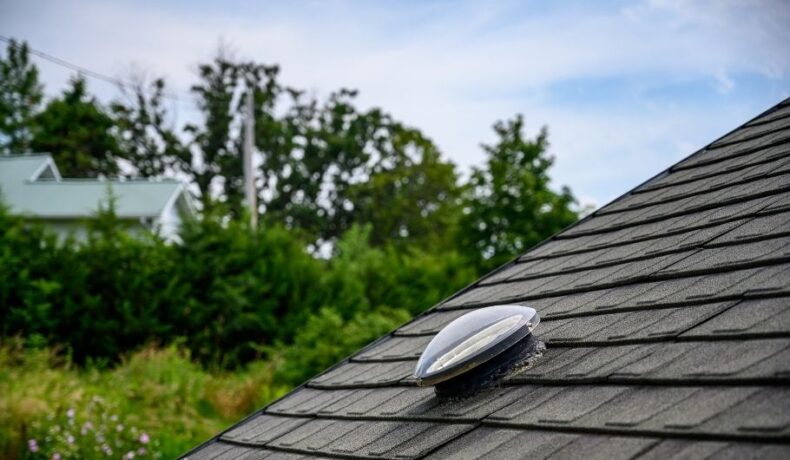Homeowners around the world are becoming increasingly aware of the costs associated with electrical lighting. Consequently, many people are turning to solar tubes and other forms of solar lighting for their household lighting needs.
Solar tubes, as opposed to traditional skylights, are a particularly attractive investment to homeowners for the following reasons:
- They are easier to install.
- Little interior finishing is required.
- Their overall cost is far less.
- They are more energy efficient.
- Less heat is emmitted from them.
- The exterior dome blocks UV rays.
- Owners can benefit from tax credits.
But enough about their overwhelming benefits.
In this article, we’re going to provide you with an overview of solar tube lighting, how these lights function, what you can expect to pay for these tubes, and more.
Table of Contents
What Are Solar Tubes?
Solar tubes, also known as “daylight pipes”, “sun tunnels”, and “sun pipes” are installations that make use of the sun to lighten up your home.
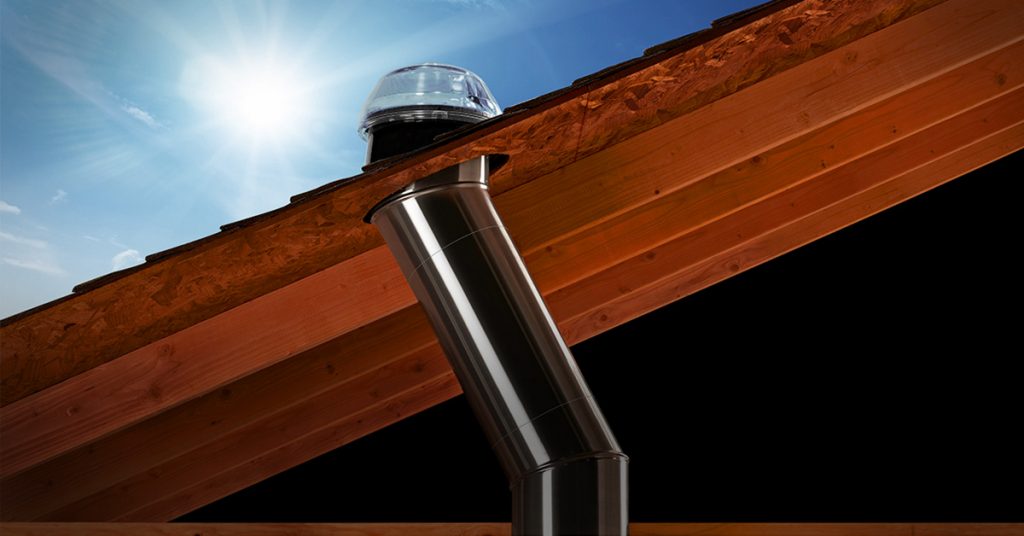
But let’s dig a little deeper, shall we?
As you may have already guessed, solar tubes require the sun’s rays to light up darkened spaces. As such, these tubes are a great alternative to electrical-based lighting systems.
The solar tube unit is installed via your ceiling and roof, with its structure being housed in a translucent, waterproof dome to protect it from the outside elements.
Unlike traditional skylights, you’ll notice that solar tubes aren’t capable of providing your home with lovely views of the outside world. This is because they are by their very nature, non-obtrusive forms of lighting that can be easily integrated into any room.
So while adding ambiance to a room may not be their strong point, they are more than capable of providing you with cost-effective, natural lighting. For reference purposes – On a sunny day, one 10-inch solar tube will provide you with around the same amount of light as three 100-watt bulbs.
How Do Solar Tube Skylights Work?
Time to have a look at how these smart contraptions work:
Solar tubes work by means of a tubular column that is installed in such a way as to penetrate the ceiling and roof of your house. By doing so, they are able to pipe daylight into your interior spaces.
Solar tube lighting consists of two tubes:
- Positive/collector tube
- Negative/emitter tube
Both of which are connected to a housing chamber.
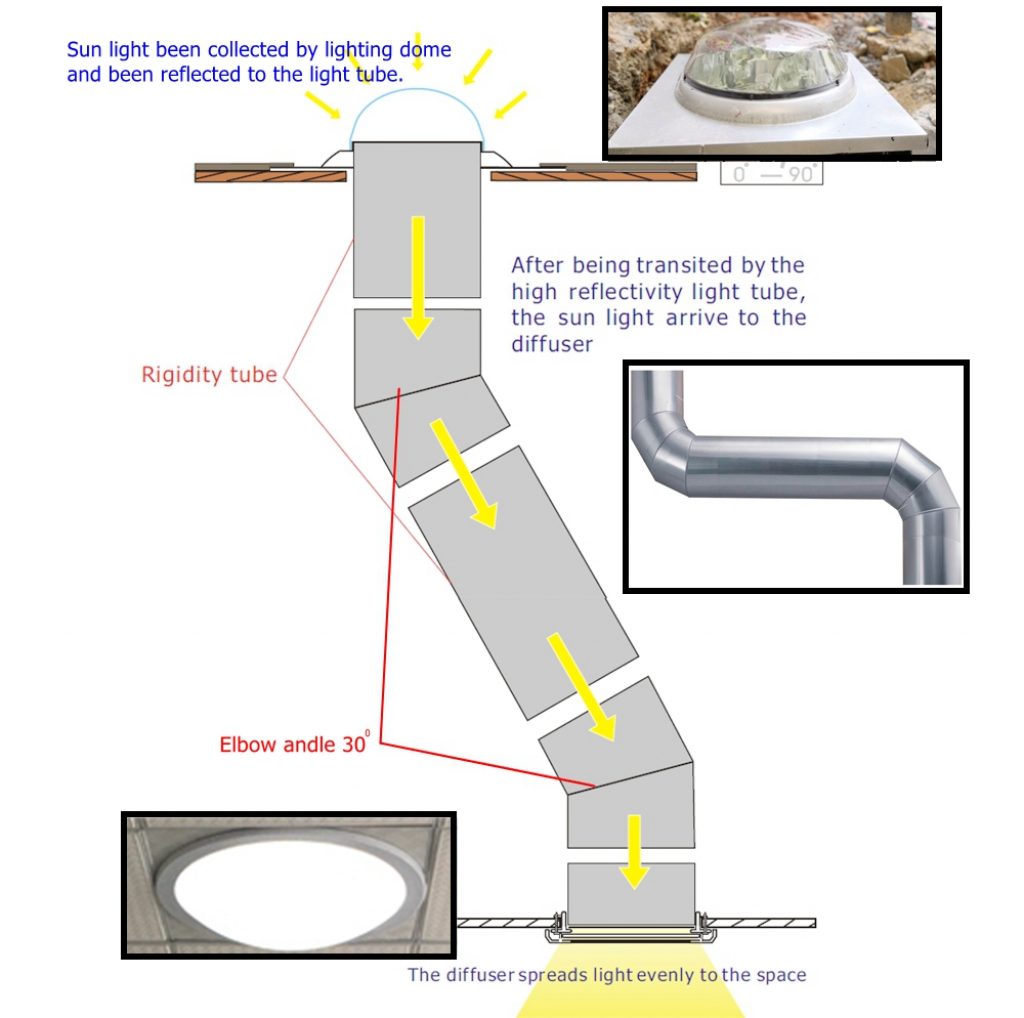
Process
The light that is produced in the housing chamber travels into the emitter tube where it’s converted into light. The light emitted by the solar tube is then collected in the housing chamber, turning the unit into a conventional lighting fixture.
“Okay, but how exactly does light travel down the tube?”
Solar tubes are comprised of a polished, reflective sheet metal that is also waterproof. This material helps to channel daylight down the length of the tube while conserving the potency of the natural light. In doing so, it can effectively distribute light into darkened areas of your home.
How Much Do Solar Tubes Cost?
Here’s some great news, right off the bat – solar tube lighting is far more cost-effective than installing skylights into your home. Additionally, this form of lighting has a relatively low-impact installation process. As such, you won’t have to concern yourself with the potential for major damage being done to your ceiling’s drywall or your roof framing.
Now for the pricing, general estimates are as follows:
A skylight can cost you between $1,540 – $2,000 (sometimes even more). Whereas a solar tube will put you back $500 – $1000 (when installed professionally).
The average price, however, hovers around the $750 mark.
These figures prove how much cheaper solar tubes are than traditional skylights.
Components
The following are a list of components that will each carry their own cost:
- Solar tube materials kit
- Professional installation
- Added extras (such as LED light kits or daylight dimmers)
Example
Velux – a company with 80 years worth of experience in the industry – provide the following solar tube lighting price range on their website:
| Sun Tunnel Size | Installation Type | Estimated Cost |
| 10″ & 14″ | Basic | $650 |
| 10″ & 14″ | Complex | $2150 |
While these prices do not necessarily fall into the aforementioned average price range, they do give an idea of price extremes relative to installation complexity.
DIY Route
If it just so happens that you are capable of and want to go the DIY route, you’ll be able to purchase and install a solar tube kit for between $200 – $400.
Tax Credits
After tallying the total cost for your solar tube lighting installation, you’ll need to factor in tax credits. We will be addressing this later on in the article.
Where Should Solar Tube Skylights Be Placed?
A significant positive of solar tube skylights lies in their design flexibility. The subtly of these natural lighting units make them appropriate for pretty much any space in your home.
In addition to this, their smaller size (significantly so in comparison to traditional skylights) makes them a practical lighting option for more compact areas, i.e a pantry area or narrow hallway.
Let’s have a look at some of the popular locations for solar tubes:
- Bathrooms
- Stairways
- Laundry rooms
- Kitchens
- Hallways
- Walk-in closets
Advice: Be aware of your solar tubes placement. The last thing you want to do is install one in an area directly above electronic screens, i.e a computer or TV screen.
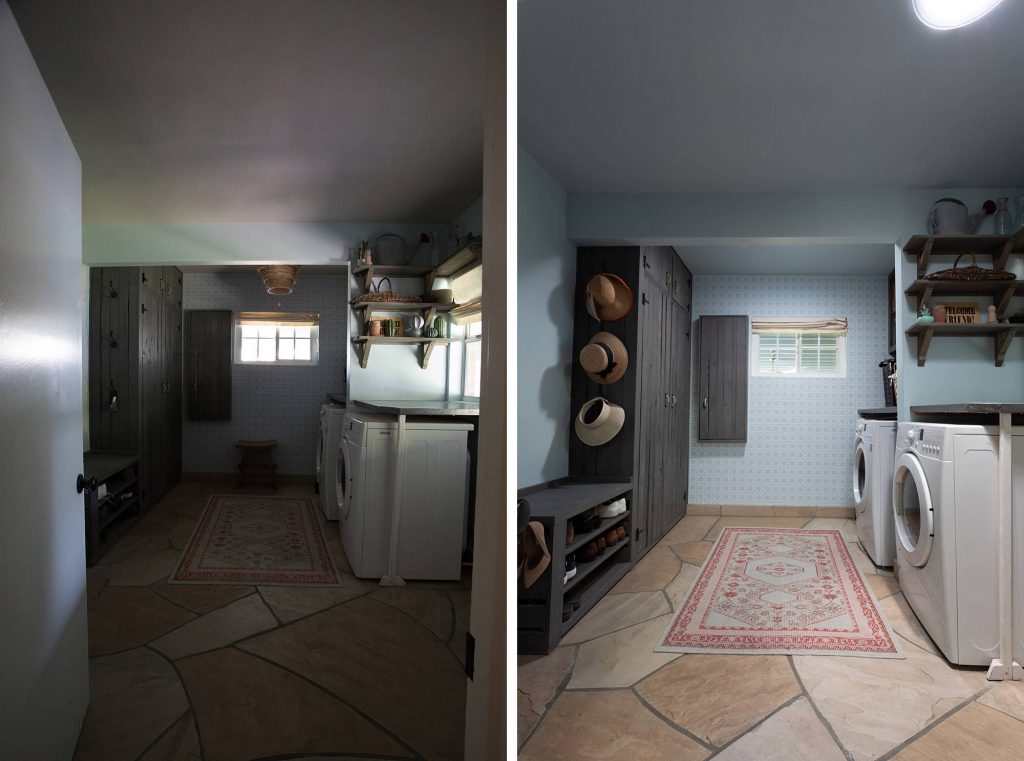
Image source: Diana Elizabeth
Housing Criteria For Solar Tubes
This is a bonus section that’ll come in handy for those of you looking to install solar tubes into your home.
You may want them, but is your home fit for solar tube installation? Have a look at the below criteria and decide for yourself.
Roof slope
First and foremost, you’ll need to take your roof’s slope into account. Most light tube kits include flashing that can be installed on roofs with slopes between 15 degrees and 60 degrees.
Roofing material
Solar tube lighting kits are primarily designed with asphalt shingles in mind. They are however also compatible with wood shingles or shakes. Additionally, flashing adapters for metal or tile roofs are available.
Roof framing spacing
Standard rafters for a home are spaced 16″ on-center – this is enough of a cap for 10″ – 14″ tubes.
If your home happens to have rafters that are positioned 24″ on-center, you’ll need to special order a 21″ tube for light coverage up to 600 square feet.
Weather
Solar tube lights can suffer from condensation buildup on the interior of the tubing. If you happen to live in an area high in humidity, this could prove to be problematic.
To offset this issue you can wrap the tube with R-15 or R-19 insulation – this will greatly reduce condensation.
Nowadays though, you’ll find that some manufacturers have built fans into sections of their tubing to remove any moist air.
What Size Solar Tube Do I Need?
Your standard solar tubes come in two different diameter sizes – 10″ and 14″ which fit between standard 16″ roof joists
Here is a basic rule of thumb when sizing the tube for a skylight installation, as per the U.S. Department of Energy: Keep the size of the light under 5% of the total room’s floor space. This is for rooms with two or more windows.
Additionally, When considering a tubular skylight for rooms that have only one window or less, it is important to figure the size of the skylight based on a ratio of no more than 15% of the room’s total floor space.
Will a Solar Tube Heat Up My House?
The short answer – no, solar tubes will not heat up your house.
This is because they give off limited passive solar heat. But what do we mean by this? Let’s use skylights as an example:
Traditional skylights have an advantage over solar tubes in that their structure is large enough and penetrable enough to create a miniature greenhouse effect. As such, they are able to warm up your household far easier.
So what does this mean for you?
- If your home has an air conditioning system, you can expect to save on electrical costs throughout summer. This is because the system won’t have to work as hard to maintain the interior temperature.
- You can also expect to save on electricity if you have a heating system that works throughout winter. This is due to the fact that heat has a tougher time escaping through a small solar tube as opossed to a traditional skylight.
Ultimately, this is a win-win for you, regardless of the season.
Do Solar Tubes Qualify For Energy Credits?
If everything you’ve read up until now hasn’t quite convinced you to invest in solar tube lighting, this section surely will.
Solar Tax Credit Overview
The federal solar tax credit is a popular financial incentive for homeowners who are looking to invest in solar technology for their homes. In short, it is a 26% tax credit that is a dollar-for-dollar reduction of the income tax that you owe.

Current Situation
Currently, the rate stands at 26% and will remain as such until the end of 2022.
Extension
If you’re concerned about whether or not this initiative is still operating, you’ll be pleased to know that they’ve extended it up until the end of 2025. However, once 2025 hits, you can say goodbye to energy credits for residential installations.
Does This Apply To Solar Tubes
Yes, it does!
Companies such as Solatube and Velux sell solar tube lighting products that fall under the solar tax credit laws.
To claim your tax credit, you simply file IRS Form 5695 and submit your receipt along with the manufacturer’s certification for the appropriate product.
Solar Tubes Vs. Skylights
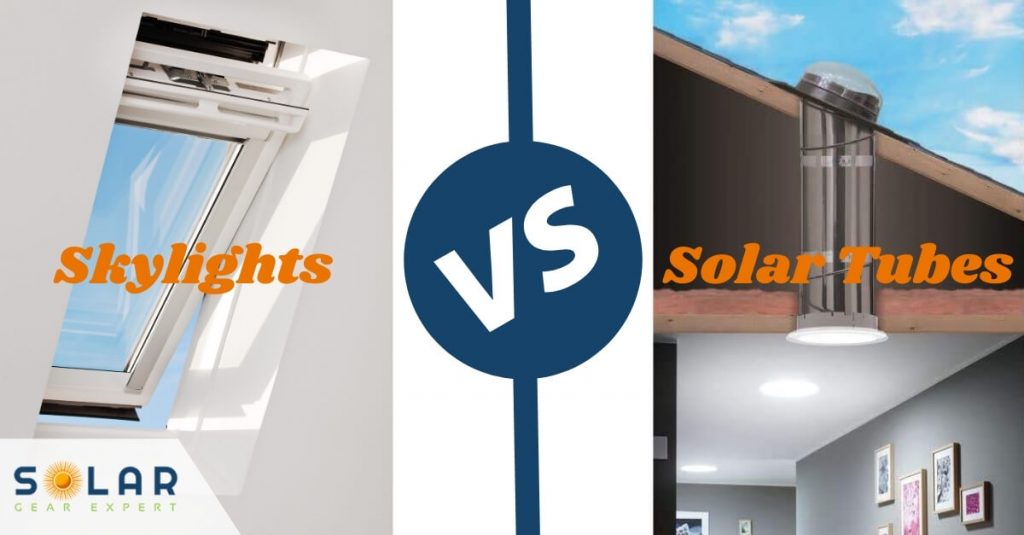
Solar Gear Expert
Some of you may still feel that traditional skylights are the way to go, and quite honestly it depends on your needs.
Both have their pros and cons. So we’ve decided to highlight the areas in which each of these options outmuscles the other.
Solar Tube Pros
Cost Effective
Solar tubes are particularly suited to homes with ample attic space.
There is no need for you to install expensive header beams, new drywall, and skylights. Instead, you can pipe sunlight through solar tubes and receive a similar level of lighting
Easy Installation
Solar tubes are far easier to install and certainly a lot quicker. Their relatively diminutive size means that they can be inserted in your roof, between rafters. In contrast, the installation of skylights requires far more precision – get something wrong and you may compromise the structural integrity of your roof.
Miminal Maintenance
Ever looked up at a skylight, only to see your view obstructed by dirt, debris, and worse yet, bird poop? Yep, not ideal. No one enjoys window cleaning, and the last thing you need is to add your sources of light to the list.
Fortunately enough, the curved design of a solar tube’s exterior head makes it far more difficult for the outside elements to settle on and obstruct your source of light.
Environmental savings
As previously mentioned, solar tubes are far better at reducing household heat gains in the summer and heat losses in the winter.
As such, you’ll be reducing the amount of electricity that you consume and thereby reducing your carbon footprint, as well – something those of us at Climatebiz greatly appreciate.
Energy Efficiency
The relatively low cost and ease of installation mean that it’s easier for you to have multiple solar tubes throughout your household. Each of these tubes acts as a light fixture in your home. Because of this, you can expect to save a significant amount on your monthly energy bill.
Cons Of Solar Tubes
No Scenic Views
Looking to add a natural light source that’ll allow for a lovely glimpse of the outside world? Unfortunately, that’s not going to be an option with solar tubes.
Their small, compact structure makes them far less suitable for viewing purposes in contrast to larger skylight windows.
Condensation Issues
As previously mentioned, solar tube lights can suffer from condensation buildup on the interior of the tubing. If you happen to live in an area high in humidity, this could prove to be problematic.
To offset this issue you can wrap the tube with R-15 or R-19 insulation – this will greatly reduce condensation.
Home Value
Many people enjoy traditional skylights because their appearance adds to the ambiance of a room. Having a view of the sky by day or night can be a way to extend the room into the outdoors. Because of this, skylights tend to increase the resale value of a home far more than solar tubes will.
Final Thoughts
If you’re looking for a relatively low-cost, non-invasive, and natural alternative to electrical lighting, solar tubes are the way to go.
Sure, they may not be able to provide you with the views that other traditional skylights can but they make up for it with their energy efficiency and low-maintenance nature.
All in all, solar tube lights offer a practical, budget-friendly option for those of you looking to harness the sun’s energy to create a warmer, natural environment in your home.

